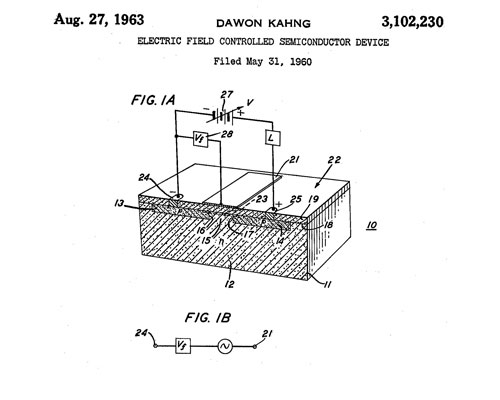
Figure from Dawon Kahang’s MOS patent
1960 - Metal Oxide Semiconductor (MOS) Transistor Demonstrated
John Atalla and Dawon Kahng fabricate working transistors and demonstrate the first successful MOS field-effect amplifier.
In 1959 M. M. (John) Atalla and Dawon Kahng at Bell Labs achieved the first successful insulated-gate field-effect transistor (FET), which had been long anticipated by Lilienfeld, Heil, Shockley and others (1926 Milestone) by overcoming the "surface states" that blocked electric fields from penetrating into the semiconductor material. Investigating thermally grown silicon-dioxide layers, they found these states could be markedly reduced at the interface between the silicon and its oxide in a sandwich comprising layers of metal (M - gate), oxide (O - insulation), and silicon (S – semiconductor) - thus the name MOSFET, popularly known as MOS. As their device was slow and addressed no pressing needs of the telephone system, it was not pursued further. In a 1961 memo, however, Kahng pointed out its potential "ease of fabrication and the possibility of application in integrated circuits." But researchers at Fairchild and RCA did recognize these advantages. In 1960 Karl Zaininger and Charles Meuller fabricated an MOS transistor at RCA and C.T. Sah of Fairchild built an MOS-controlled tetrode. Fred Heiman and Steven Hofstein followed in 1962 with an experimental 16-transistor integrated device at RCA.
Dr. Dawon Kahng, 61, Inventor In Field of Solid-State Electronics - New York Times
Meet the 2009 National Inventors Hall of Fame Inductees - Hall of Fame









